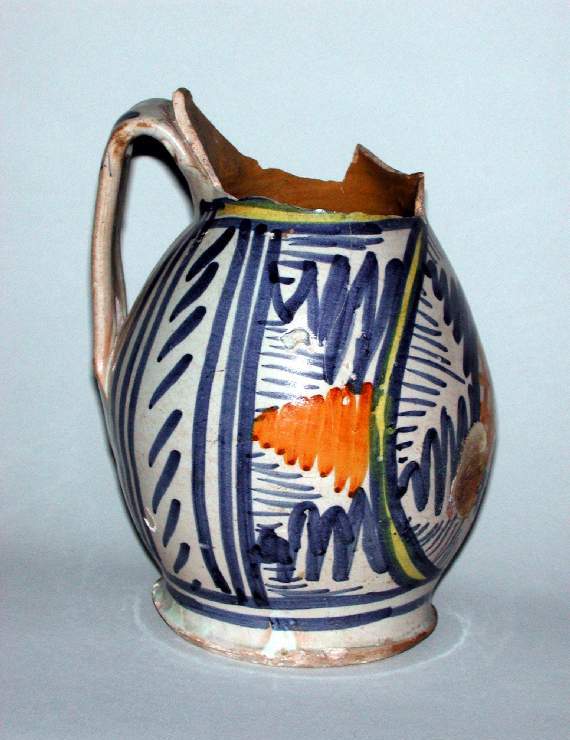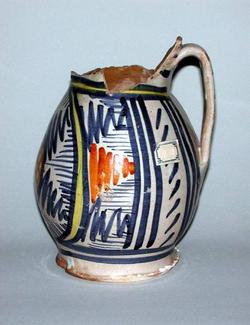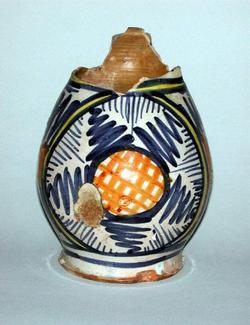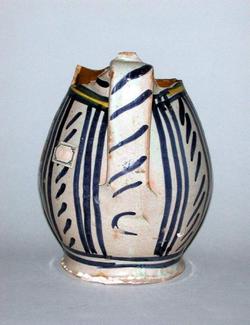Current Location: In storage
Maker(s)
Pottery:
Unidentified Orvieto pottery
(Probably)
Pottery:
Unidentified Deruta pottery
(Perhaps)
Entities
Categories
Description
Cream earthenware, thrown. The interior is lead-glazed pale yellowish-brown; the exterior is tin-glazed; the base is unglazed. The front has a large fault where the vessel has adhered to another during firing. Painted in blue, yellow, and orange.
The front is decorated with a sunburst comprising a chequered centre, five blue rays enclosed by a yellow circle between two blue, and on each side, an orange ray between two blue. The handle is flanked by slanting strokes between two sets of three vertical lines. Round the neck is a yellow horizontal band between two blue; round the base, two blue bands; and, down the back of the handle, five slanting strokes with a `C' below.
Notes
History note: This jug came to the Fitzwilliam in a crate of sherds of Orvieto and other Italian maiolica accompanied by a label inscribed 'Mostly bought at Orvieto, some pieces,/marked P at back) from Perugia. The Orvieto pieces, with a few exceptions,/were found in excavating the foundations for houses near the Cathedral./ Presented by R.C. Bosanquet M.A./ 1904/ Also a squat jug (Caffaggiolo ware?) with blue and orange decoration: another/jug with escutcheon: & a fruit dish/(Urbino ware?: P all three from the same find.' This was the only jug decorated in blue and orange in the crate, so it is presumably the one mentioned, but it is unclear from this whether the three pieces were all from the 'same find' as the fragments in Orvieto, or from another location. However, as the jug with an 'escutcheon' bears arms which appear in a fresco in the Duomo at Orvieto, it seems likely that the find was in Orvieto.
Legal notes
Given by Professor R.C. Bosanquet
Measurements and weight
Height: 18.8 cm
Acquisition and important dates
Method of acquisition: Given
(1904)
by
Bosanquet, R. C.
Dating
15th Century, Late
16th Century, Early
Renaissance
Circa
1480
CE
-
1520
CE
Note
The attribution of this jug tentatively to Caffaggiolo on the label which accompanied R.C. Bosanquet's donation is unlikely given its purported find site near the Cathedral in Orvieto. It is more likely to have been made in Orvieto, or possibly in Deruta which exported maiolica to Orvieto. See the notes below.
School or Style
Renaissance
People, subjects and objects depicted
Components of the work
Decoration
composed of
high-temperature colours
( blue, yellow and orange)
Interior
composed of
lead-glaze
Exterior
composed of
tin-glaze
Base
Diameter 10.2 cm
Body
Materials used in production
Earthenware
References and bibliographic entries
Related exhibitions
Identification numbers
Accession number: C.92-1904
Primary reference Number: 76384
Stable URI
Audit data
Created: Saturday 6 August 2011
Updated: Tuesday 13 August 2024
Last processed: Tuesday 2 September 2025
Associated departments & institutions
Owner or interested party:
The Fitzwilliam Museum
Associated department:
Applied Arts







